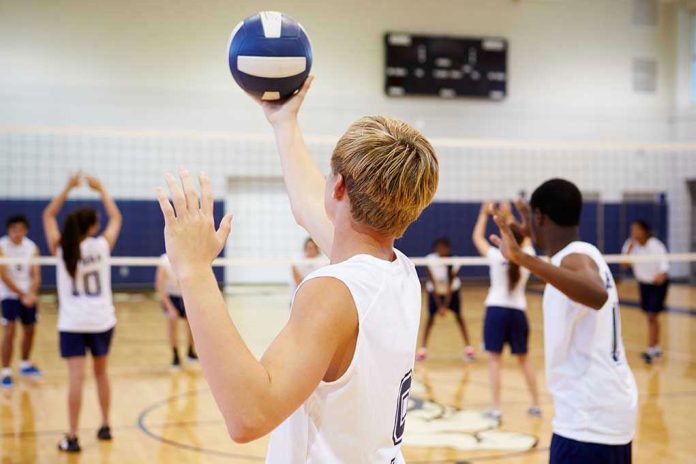
After years of controversy, President Trump’s administration moves to safeguard girls’ sports, confronting what many see as the erosion of fairness and common sense under leftist policies.
Story Snapshot
- Trump’s executive orders bar transgender girls from competing in girls’ and women’s sports, threatening to withhold federal funding from non-compliant states and universities.
- University of Pennsylvania issues a public apology to female athletes “disadvantaged” by Lia Thomas, updating records after federal pressure.
- Over 20 states have enacted bans on transgender girls in girls’ sports, with new rules and ongoing court challenges shaping the national landscape.
- The debate is framed as a fight for fairness and the protection of opportunities for biological female athletes.
Trump Administration Acts to Restore Fairness in Girls’ Sports
In 2025, the Trump administration took decisive action to address what many Americans viewed as a fundamental threat to fairness in girls’ and women’s sports. Through a series of executive orders, President Trump required all states and universities receiving federal funds to bar transgender girls—individuals assigned male at birth who identify as female—from competing in girls’ sports. This sweeping federal intervention followed years of frustration among parents, athletes, and advocates who argued that leftist policies had undermined the level playing field that Title IX was designed to protect.
The administration’s policy marked a dramatic reversal from the previous White House, which promoted inclusion based on gender identity. Trump’s orders were clear: compliance was not optional. Institutions refusing to adopt the ban risked losing vital federal funding, a move that forced universities and athletic associations to confront the issue head-on. The decision was met with strong support from conservative lawmakers and traditional-values groups, who had long decried the perceived unfair physical advantages retained by transgender athletes who had experienced male puberty.
High-Profile Cases and State-Level Action Fuel National Outcry
The battle over the integrity of girls’ sports reached a boiling point after high-profile cases, most notably Lia Thomas’s participation in collegiate women’s swimming. Thomas, a transgender woman, broke several records while competing for the University of Pennsylvania, sparking widespread backlash. In response to both the competition and federal pressure, UPenn publicly apologized in July 2025 to female athletes who were “disadvantaged,” updating official records to reflect the change in policy. This move was seen by many as a long-overdue acknowledgment of the harm caused by policies that prioritized inclusion over fairness for biological females.
At the state level, over twenty legislatures, including Idaho, Florida, and California, passed laws restricting transgender girls’ participation in female sports. Legal challenges and protests erupted, but the momentum remained with those demanding protections for girls. The California Interscholastic Federation, for example, implemented a new pilot entry process following community outrage over a transgender athlete’s participation in girls’ volleyball, illustrating how grassroots activism and parental pressure were influencing national policy.
Fairness, Science, and Conservative Values Drive the Debate
Supporters of the bans argue that fairness and safety are at stake, citing the well-documented physical advantages that male puberty confers—even after hormone therapy. Many sports scientists acknowledge that while testosterone suppression reduces some physical differences, it does not fully eliminate advantages in strength, speed, and endurance. Critics of inclusion policies maintain that allowing biological males to compete in girls’ sports undermines the very essence of competition, discourages participation, and threatens the opportunities that Title IX aimed to secure for women and girls.
Advocacy groups such as Alliance Defending Freedom have championed legal defenses for female athletes, while political leaders have rallied voters with a message rooted in common sense and the defense of family values. The issue has also exposed stark political divisions, with Democrats largely opposing restrictions and Republicans framing the debate as a “90-10” wedge issue—one that resonates powerfully with the majority of American families who want to see fairness restored.
Ongoing Legal Battles and the Road Ahead
Despite the Trump administration’s aggressive push, the legal landscape remains unsettled. Some states’ bans have been blocked or delayed by court rulings, and advocacy groups continue to challenge the constitutionality of the executive orders. Sports governing bodies, such as the NCAA, are caught between conflicting state, federal, and internal policies, revising eligibility rules as the tug-of-war continues. Nonetheless, the direction is clear: the federal government’s stance now prioritizes fairness and the protection of girls’ athletic opportunities over radical social experiments. Parents, athletes, and taxpayers alike are watching closely, determined not to let political agendas undermine the fundamental values that built American sports.
Yes, Having a Boy on a Girl's Volleyball Team Is Unfair https://t.co/bkmScfslC7
— Observing Time 🏴☠️ (@TimeObserving) August 26, 2025
As the court battles and policy debates continue, one fact remains: for millions of Americans, the restoration of equal opportunity and protection of girls’ sports is not only a policy preference but a deeply held conviction. The Trump administration’s actions have emboldened those who felt sidelined during years of “woke” overreach, signaling a renewed commitment to fairness, biological reality, and the conservative values that unite the nation’s families.
Sources:
The History of Transgender Athletes in Sport
Trans women in sports: facts over fear
Timeline of the trans athletes in sports debate – KMPH
Transgender athlete laws, state legislation, science – ESPN












